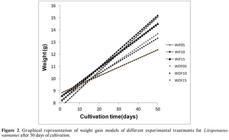ABSTRACT
The cultivation of Litopenaeus vannamei has increased in inland areas by using low salinity waters. Cultivation techniques in coastal waters are well developed, however, studies for low salinity conditions are needed, especially regarding the ideal ionic composition of water and its effects on the zootechnical indices. Brazil has adopted this strategy and the semiarid region showed great potential due to its favorable climate and water conditions. Thus, experimental cultivations were conducted in Serra Talhada, State of Pernambuco, in order to evaluate the influence of two feeding strategies (with and without feeding) and three cultivation densities (5, 10 and 15 shrimps m-2), on the production variables of this species. Three ponds of 280 m2 were built, in which six nursery nets of 20 m2 were installed. The cultivation was performed with juvenile shrimps of 8.53 g and lasted 50 days. The animals were fed twice a day with commercial feed containing 25% of crude protein. The water quality (salinity ~1.0 g L-1, temperature ~28.09°C, pH ~8.48) and the shrimp growth were monitored with weekly biometry during the cultivation. A significant difference was found only in the treatment without feeding with 15 shrimps m-2, the average final weight of all treatments ranged from 13.16±1.33 g to 15.50±1.66 g. The survival rates were high in the treatments with feeding and its variation between treatments was 60.56±6.76% and 83.00±4.00%.
Keywords:
Litopenaeus vannamei; Low salinity; Semiarid

 Thumbnail
Thumbnail
 Thumbnail
Thumbnail
 Thumbnail
Thumbnail







